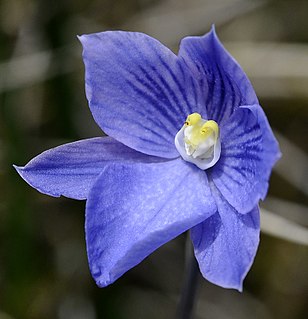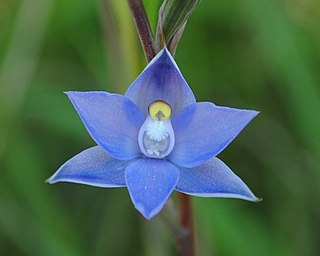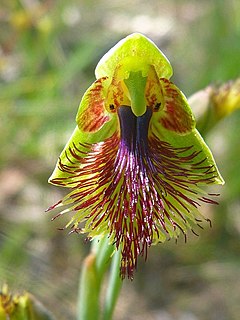
Thelymitra, commonly known as sun orchids, is a genus of more than 100 species of plants in the orchid family, Orchidaceae. Unlike most other orchids, sun orchids lack a highly modified labellum and all three petals are similar in size, shape and colour. The column is, however, highly modified and usually has prominent wings or glands which are helpful in identifying the species. Most sun orchids close their flowers at night, in cloudy or cool weather, giving rise to their common name. The scientific name means "woman's hood" and refers to the hooded column present in most, but not all species. Most species are endemic to Australia although some are found as far from there as the Philippines and Indonesia. The type species, Thelymitra longifolia, the first to be formally described, was collected in New Zealand.

Pterostylis curta, commonly known as the blunt greenhood, is a species of orchid found in south-eastern Australia, Lord Howe Island and New Caledonia. It has a rosette of leaves at its base and a single white and green, forward leaning flower with a brown tip and a twisted labellum.

Thelymitra cyanea, commonly known as the veined sun orchid in Australia and as the swamp sun orchid or striped sun orchid in New Zealand, is a species of orchid which is native to New Zealand and south-eastern Australia. It has a single erect, fleshy, channelled leaf and up to five bright blue flowers with darker blue veins. It is usually found growing in swamps, sphagnum bogs, and subalpine herbfields, often in clonal colonies.
Epiblema grandiflorum, commonly known as babe-in-a-cradle, is the only species in the flowering plant genus Epiblema in the orchid family, Orchidaceae and is endemic to the south-west of Western Australia. It is a colony-forming orchid which grows in peaty swamps near the coast. Its flowers are purple with ribbon-like strands attached to its labellum and a broad, petal-like column.

Caladenia minorata, commonly known as the small waxlip orchid, is a plant in the orchid family Orchidaceae and is endemic to eastern Australia. It is a ground orchid with a single very hairy leaf and one or two deep violet-blue flowers. It has been known as Glossodia minor since its description by the prolific Scottish botanist Robert Brown in 1810, but recent discoveries suggest its inclusion in the genus Caladenia. It is similar to Caladenia major but is smaller in all its parts.

Pterostylis cucullata, commonly known as the leafy greenhood, is a plant in the orchid family Orchidaceae and is endemic to south-eastern Australia. It has a rosette of fleshy leaves at its base and a single white, green and reddish-brown flower.

Pterostylis squamata, commonly known as the southern rustyhood or ruddyhood, is a plant in the orchid family Orchidaceae and is endemic to south-eastern Australia. Flowering plants have up to ten translucent green flowers with reddish-brown markings and a hairy, insect-like labellum. Non-flowering plants have a rosette of four to eight egg-shaped leaves. This species is very similar to Pterostylis rufa which has a narrower labellum and other minor differences.
Pterostylis dubia, commonly known as the blue-tongued greenhood, is a plant in the orchid family Orchidaceae and is endemic to Tasmania. It has a rosette of fleshy leaves at its base and a dark green and white flower with narrow petals and a dark blue-green labellum.

Pterostylis gibbosa, commonly known as the Illawarra rustyhood, or Illawarra greenhood, is a plant in the orchid family Orchidaceae and is endemic to New South Wales. It has a rosette of leaves at its base and up to nine bright green flowers with translucent "windows", relatively wide lateral sepals with short-pointed tips and a dark, fleshy, insect-like labellum.

Pterostylis reflexa, commonly known as the dainty greenhood, is a species of orchid endemic to New South Wales. As with similar greenhoods, the flowering plants differ from those which are not flowering. The non-flowering plants have a rosette of leaves flat on the ground but the flowering plants have a single flower with leaves on the flowering stem. This greenhood has a relatively large white, green and light brown flower with a long, curved dorsal sepal and a protruding labellum.

Thelymitra nuda, commonly known as the plain sun orchid is a species of orchid that is endemic to eastern Australia. It has a single fleshy, channelled leaf and up to twelve dark blue to purplish, sometimes white or pinkish flowers with white tufts on top of the anther. It grows in a range of habitats and sometimes forms large colonies.
Corunastylis nigricans, commonly known as the Kangaroo Island midge orchid is a small terrestrial orchid endemic to South Australia. It has a single thin leaf and up to twenty five purplish brown flowers with a shiny, hairless, dark purplish labellum. It is sometimes confused with Genoplesium nigricans which has differently coloured flowers and a much wider distribution. It is regarded as a synonym of G. nigricans by the World Checklist of Selected Plant Families.

Thelymitra carnea, commonly called the tiny sun orchid or pinkish sun orchid, is a species of orchid that is native to Australia and New Zealand. It has narrow, almost cylindrical leaves and up to four relatively small pale to deep pink flowers on a wiry, zig-zag stem.
Thelymitra angustifolia, commonly known as the long-leaved sun orchid is a species of orchid that is endemic to eastern Australia. It has a single erect, thin, channelled leaf and up to ten purplish blue flowers with white tufts on top of the anther. The flowers are self-pollinating.
Thelymitra media, commonly called the tall sun orchid, is a species of orchid that is endemic to eastern Australia. It has a single fleshy, channelled leaf and up to thirty blue flowers with darker streaks but without spots. The labellum is narrower than the other petals and sepals.

Thelymitra canaliculata, commonly called the flushed sun orchid or blue sun orchid is a species of orchid in the family Orchidaceae and is endemic to the south-west of Western Australia. It has a single erect, fleshy leaf and up to twenty eight blue flowers with darker veins and sometimes flushed with pink. The lobe on top of the anther is blackish with a yellow crest.
Thelymitra fuscolutea, commonly called the chestnut sun orchid, is a species of orchid in the family Orchidaceae and is endemic to the south-west of Western Australia. It has a single erect, flat, leathery leaf and up to fifteen or more yellowish green flowers with reddish brown streaks and blotches. The column has broad, deeply fringed cream or whitish wings.
Thelymitra tigrina, commonly called the tiger orchid or tiger sun orchid, is a species of orchid that is endemic to the south-west of Western Australia. It has a single narrow leaf and up to fifteen small yellow flowers with small brown spots.

Calochilus campestris, commonly known as the copper beard orchid, is a species of orchid endemic to south-eastern Australia. It has a single fleshy, channelled leaf and up to fifteen pale green and red flowers with a purple "beard".
Dendrobium rigidum, commonly known as the smooth tongue orchid or smooth tick orchid, is a species of orchid native to tropical North Queensland and to New Guinea. It is an epiphytic or lithophytic orchid with wiry, hanging stems, fleshy, dark green leaves and flowering stems with between two and seven crowded, cream-coloured, star-shaped flowers often with pink or red on the back. It grows on trees, shrubs and rocks in a paperbark swamps and rainforest.












